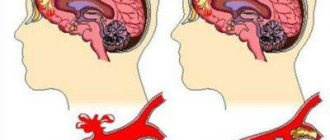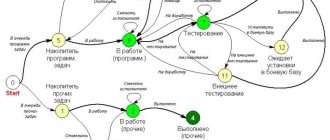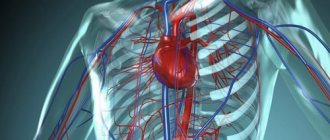Venous stagnation is accompanied by impaired blood flow from organs and tissues (muscles, skin, mucous membranes). It is always accompanied by a decrease in blood flow speed and increased thrombus formation. Synonymous names: venous hyperemia, blood stasis.
The tone of the venous vessels first increases as much as possible, then decreases. Overflow creates increased pressure in the venous part of the capillary bed, which also disrupts the arterial inflow. Tissues and organs suffer from oxygen deficiency.
But you should not blame only the vascular network for venous stagnation; there are many reasons that provoke pathology. Depending on the distribution, stasis can be local or general.
Which organs suffer most from stagnation, the mechanism of damage
The entire body suffers from hypoxia, because all systems are tightly connected by the vascular network. But for certain diseases, maximum changes are possible in:
- brain,
- lung tissue,
- kidneys,
- pelvic organs,
- lower extremities.
At any localization, venous congestion is manifested by the following disorders:
- slowing blood flow;
- violation of the pressure ratio in the venous and arterial “arm” of capillaries in the direction of growth in the veins;
- reduced temperature over the area of stasis;
- significant expansion of venules and capillaries;
- pendulum-like movement of blood in venules with impaired separation into layers of plasma and cellular elements;
- simultaneous stagnation of lymph.
Excess liquid plasma compresses adjacent anatomical formations and passes into cavities (pleura, pericardium, peritoneum, intracranial bone sinuses).
Destruction of the walls of blood vessels and increased pressure causes the release of red blood cells into the surrounding space. This is accompanied by small hemorrhages in the skin and serous membranes.
Organs in conditions of overflow with venous blood look increased in volume due to swelling, dense, and bluish in color.
Let us consider separately the reasons that lead to manifestations of stagnation in different organs.
Symptoms
The disease can manifest itself with numerous symptoms. So, what characteristic signs should be noted for disorders of the venous outflow of the brain?
- Severe and dull pain. Moreover, pain most often manifests itself in the morning.
- It is difficult for a person to get out of bed, because he understands that his body does not obey him. In addition, severe lethargy is manifested in combination with weakness.
- Pain sensations actively increase if a person tries to move his head. In addition, even the slightest movements turn out to be dangerous.
- There is increased sensitivity to atmospheric pressure, alcohol consumption, stress and serious anxiety.
- Attacks may result in buzzing and noise in the head, cyanotic lips, nose, ears, mouth and cheeks.
The above symptoms can lead to numerous unpleasant situations that are best prevented when the opportunity arises.
In order to prevent partial fainting, the development of epilepsy and the appearance of a feeling of stupor, it is extremely important to provide the correct approach to treatment. Only in this case can you be guaranteed to get a decent result and the ability to prevent unwanted symptoms.
When does congestion develop in the veins of the brain?
Venous congestion of cerebral vessels is possible when the regulation of vascular tone by the circulatory centers is disturbed. The compensatory function is performed by the bone sinuses. But they are not able to accept large amounts of blood, since they are also collectors for cerebrospinal fluid. Therefore, congestion is accompanied by increased intracranial pressure and excess fluid in the ventricles of the brain.
The outflow from the head occurs through the jugular and internal carotid veins, located in the neck outside the skull, so the causes of stagnation do not always lie in the brain
They need to be looked for in the immediate areas of the head and neck.
The most common:
- thrombophlebitis of the cerebral veins;
- inflammation of the membranes and tissue in infectious diseases (encephalitis, meningitis);
- venous thromboembolism from blood clots from stroke sites;
- developmental anomalies (expansion, increased tortuosity, aneurysms);
- hydrocephalus (water on the brain) when the ventricular area is affected;
- post-traumatic damage;
- tumors of a benign or malignant nature in the brain or in the neck;
- osteochondrosis of the cervical vertebrae, compressing the vertebral veins;
- chronic diseases of the heart, bronchi, and lungs, causing a delay in the outflow through the veins from the head when the right atrium and ventricle are overloaded;
- hormonal changes affecting vascular tone.
Prevention of venous stagnation
In addition to the treatment prescribed by the doctor, medicinal massage is also used, but very carefully and only by a specialist.
You can do some physical exercise on your own every day. They will help relieve pain, improve venous outflow and maintain neck muscle tone. Medicines are prescribed only after a complete diagnosis of the cervical spine. If osteochondrosis of the cervical spine is in an advanced stage and there are obvious manifestations of a mental disorder, then drugs are prescribed from the group of neuroprotectors. They will help to gradually restore the metabolic process in the brain, eliminating the negative consequences of osteochondrosis and restoring venous outflow.
To restore sleep disorders and neuroses, the doctor may prescribe sedatives. Remember to approach the treatment of venous outflow disorders in the cervical spine in a comprehensive manner and under the supervision of specialists.
Causes and manifestations of congestion in the veins of the lungs
Venous congestion in the lungs is accompanied by loss of alveolar air space due to compression by edematous interalveolar septa. Fluid and red blood cells gradually exit into the alveoli. The lung tissue becomes dense and brown in color due to the accumulation of hemosiderin (a product of unfinished oxidation of hemoglobin).
The acute course of the pathology causes pulmonary edema. Chronic - proliferation of fibrous tissue, severe respiratory failure.
The reasons may be:
- the formation of heart failure of the left ventricular type after acute myocardial infarction, against the background of cardiosclerosis;
- stenosis of the aortic mouth, sclerosis of the valves;
- mitral stenosis in rheumatism.
In the formation of clinical signs the following are important:
- impaired mobility of the diaphragm;
- increased pressure in the pulmonary circulation.
Characteristic symptoms:
- constant shortness of breath;
- cough with sticky sputum and streaks of blood;
- general weakness.
Upon examination, the doctor will find a mass of wheezing wheezing against the background of hard breathing over the entire surface, and in the lower sections there are moist fine bubbles. Auscultation of the heart will reveal murmurs typical of the defect.
Often venous congestion in the lungs is part of general heart failure. Therefore, other symptoms are possible:
- swelling in the legs;
- •palpation of an enlarged, painful liver;
- pleural effusion with fluid accumulation;
- abdominal enlargement due to ascites.
Doctors must differentiate radiological signs of congestion from pneumonia
Based on radiological signs, it is customary to distinguish 4 degrees of congestion in the lungs:
- Degree 1 - the pattern of veins is enhanced only in the upper lobes, their overflow is observed.
- Degree 2 - the vascular pattern is enhanced in all parts, the roots of the lungs are expanded.
- Degree 3 - the swelling is called interstitial, the contours of the vessels are poorly visible, changes in the structure of the roots.
- Degree 4 - edema extends into the alveoli, the roots are enlarged, their boundaries are blurred, shadows in the lung tissue, and possible accumulation of fluid in the pleural cavities.
To treat congestion, it is necessary to cope with heart failure with the help of pharmaceuticals (glycosides, diuretics), and to perform surgery to correct the defect.
Manifestations of venous stagnation in the kidneys
Kidney congestion occurs in chronic heart failure. Filtration in the glomeruli decreases sharply. Water and sodium ions are not excreted, plasma accumulates. The kidneys are full-blooded and dense. Symptoms are hidden by the general clinic of heart failure, but provocation of complications is possible. These include:
- urolithiasis disease;
- pyelonephritis and glomerulonephritis;
- persistent symptomatic hypertension.
Under conditions of primary urine stasis, minerals and salts precipitate more easily and stones form. Associated infection from internal foci develops on favorable soil.
Treatment consists of antibiotics, kidney surgery and a nephrostomy tube to drain excess fluid.
Congestion in the pelvic veins
We also recommend reading:Running for varicose veins
The phenomenon of stagnation in the veins of the pelvis is very common among the adult population, both female and male. The causes of the pathology are:
- pregnancy period in women;
- hormonal contraceptives;
- inflammatory diseases of the genital organs;
- sedentary lifestyle and work;
- use of tightening belts, corsets;
- excess weight;
- carrying heavy objects, high physical activity when playing sports;
- emotional overload.
For women, venous congestion is dangerous for the development of miscarriages, infertility, and premature birth with a premature baby.
In men, venous stagnation provokes:
- early prostatitis;
- enlargement of adenoma;
- urethritis;
- disruption of the production of sex hormones in the testicles;
- primary infertility.
Prolonged sitting causes an increase in the temperature of the scrotum, which for normal functioning of the testicles must be 3 degrees below the body.
Therefore, the issues of preventing stagnation in the pelvis are so important for people of both sexes.
On the right is a special chair for solving men's problems
First of all:
- provide breaks during sedentary work for walking;
- perform exercises that ensure the outflow of venous blood;
- do not indulge in smoking, alcohol, or spicy foods, as they disrupt the tone of the veins;
- engage in feasible sports, without overload.
Classification of venous discirculation according to Berdichevsky
In 1989, domestic scientist M.Ya. Berdichevsky, relying on the forms of manifestation of venous stasis of cerebral vessels, identified two types of pathology. It is this division that doctors follow to this day.
- Primary form
The tone of the veins changes: the outflow of venous blood decreases. Provoked by: traumatic brain injuries, intoxication (including constant abuse of alcoholic beverages), smoking, heart failure, urgent conditions, exposure to ultraviolet radiation (prolonged exposure to the sun), endocrine pathology.
- Stagnant form
It occurs due to mechanical reasons: something physically interferes with the normal outflow of blood. The stagnant process in this case is long-lasting. It has an extremely negative effect on the functioning of internal organs, disrupting their functions.
What exercises are recommended to prevent pelvic congestion?
Movement is a confirmation of the vitality of a person, his organs and systems. With the modern “sedentary” lifestyle, it is necessary to artificially add load so that the natural properties of protection can fully work.
The proposed set of exercises is also suitable for the prevention of varicose veins. It is recommended to exercise at least twice a day. If possible, during lunch break. You can select a load that suits the performance conditions.
"Seated" exercises
Contract the gluteal muscles with force, one at a time and together. “Dance” on your buttocks to the music.
Standing
- perform 20 rotational movements of the pelvis in one direction and the same in the other;
- squeeze your lower abdominal muscles and buttocks, pull your tail as far inward as possible and work your pelvis back and forth 10 times;
- make a figure eight with your pelvis to the sides;
- walk in place with your knees raised high forward, then abducted and swept back;
- Bends to the sides can be performed by squeezing (for example, tilt to the left with your right hand raised, without leaving the tilted position, try to bend even lower with pushes 20 times), to enhance the action, you can take a load in your lower hand;
- squats are performed with the legs as wide as possible (wider than the shoulders) and with emphasis on the heels; without lifting the heels, you should pull the buttocks back; the exercise is more effective if done at a slow pace.
The lower bar engages many muscles that shape posture and figure.
Exercises to perform while lying down
- bend your knees while lying on your back and raise your pelvis as high as possible, while not letting go of your abs and buttocks, hold for half a minute in a static position, then do another 20 pushes with your stomach up;
- from the same static position, alternately straighten your legs;
- leave the emphasis on the left leg, bend the right at the knee and place the foot on the thigh of the left, repeat the pulse impulses upward, then change legs;
- spinning imaginary bicycle wheels;
- hold the plank on your outstretched arms and toes for a minute, then move to a low plank on your elbows;
- raise your legs at an angle of 90 degrees, bend your knees, using your abdominal muscles, try to lift your pelvis up, perform 20 times;
- “scissors” with extended and tense legs at an angle to the floor of 45 degrees.
How does congestion manifest in the veins of the legs?
Varicose veins, known to everyone, are a clinical manifestation of blood stagnation in dilated veins that have lost their tone.
Symptoms of pathology:
- dull pain and heaviness in the muscles that develop in the evening;
- swelling on the feet and legs against the background of bluish skin of the fingers;
- chilly feet even in summer;
- manifestations on the skin in the form of a light mesh on the hips, under the knees, on the legs;
- disruption of tissue trophism in later stages (non-healing cracks in the skin of the feet, ulcers).
You can read about the treatment of varicose veins on our website in this article.
Inactive deep vein valves take part in the mechanism of venous stagnation of the legs
How does venous stasis develop and what threatens it?
You all probably know that blood, saturated with oxygen and nutrients, is carried from the heart to all organs by arteries. In this case, large vessels are divided into smaller arterial capillaries.
Having reached the tissues of the organs, the blood gives them everything useful and takes away metabolic products (including carbon dioxide), traveling through the veins back to the heart. The neck contains large arteries that supply the main human organ – the brain.
Veins and venous plexuses pass here, carrying blood in the opposite direction. Due to osteochondrosis in the cervical spine, muscle tone and their pressure on the vessels increase. In this case, venous outflow from the cranial cavity may be difficult, causing stagnation of blood in the head.
At the same time, the veins swell, and harmful elements - toxins - accumulate in the brain cells. This leads to spasm of arterial capillaries and deterioration in the nutrition of neurons - nerve cells.
The condition is accompanied by the following symptoms:
- high intracranial and intraocular pressure;
- arterial hypertension (high blood pressure);
- frequent headaches - they intensify when turning and tilting the head, changing weather, in stressful situations, after drinking alcohol;
- dizziness, up to loss of consciousness;
- nausea, vomiting;
- tinnitus – felt even when lying down and after sleep;
- deterioration of vision - “floaters” appear, image clarity is disrupted;
- increased body temperature;
- bluish complexion, swelling of the lower eyelids in the morning (“bags” under the eyes);
- swelling of the legs;
- muscle weakness;
- numbness of the limbs;
- poor coordination of movements, unsteady gait;
- pain in the heart and tachycardia (increased number of heartbeats), less often - bradycardia (slow heart rate);
- mental disorders, development of dementia (typical of old age);
- epilepsy attacks.
Of course, the appearance of all these signs at the same time is not necessary; it all depends on the severity of the disease and its stage.
Medicines used to eliminate venous stagnation
Regardless of the form of stagnation and damage to internal organs, treatment requires drugs that increase venous tone, reduce the tendency to thrombus formation and prevent phlebitis. For this purpose, the doctor’s “arsenal” includes:
- venotonics - increase the elasticity of the venous wall, tone the muscles (Eskuzan, Phlebodia 600, Troxevasin);
- to reduce blood clotting and improve its fluidity, anticoagulants such as Warfarin, Plavix, Thrombo ACC are needed;
- preparations with caffeine increase muscle tone;
- Diuretics allow you to remove excess fluid.
For patients, medical specialists can recommend special products that improve the trophism of the affected organs and help maintain function. Dosage and courses of treatment are prescribed only by a doctor. You cannot increase the dose or cancel treatment on your own. Venous congestion can serve as an initial sign of various diseases, so if you feel the symptoms, you need to see your doctor.










